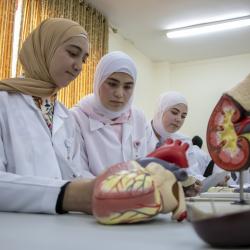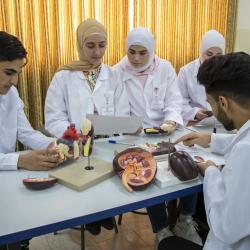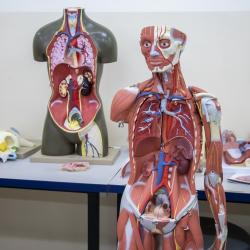The Anatomy and Physiology Lab is a comprehensive educational environment that includes anatomical models and advanced 3D applications, allowing students to explore the human body in realistic and interactive ways. The models enable in-depth study of the skeletal structure and organs, while 3D applications provide precise visualization of intricate details such as blood vessels, nerves, and muscle movements. This enhances students' understanding of vital concepts and the clinical skills required in the nursing field.
- Introducing students to all body systems and the organs that constitute each system.
-Teaching students the anatomical location of each organ in the body.
-Familiarizing students with the structure and composition of each organ.
-Understanding the function of each organ.
-Conducting blood type tests and electrocardiograms (ECG).
Second-year nursing students.
Anatomy and Physiology Lab (Course Code: 22091).
-This course aims to provide nursing students with a comprehensive understanding of the anatomical structure and physiological functions of the human body through the use of modern technology and 3D models. The language of anatomy is also presented in a simplified and practical manner for healthcare providers. The course offers an interactive learning experience that combines theoretical study with practical application using the latest technological tools, working in small groups to achieve the educational objectives.
Anatomical models of all human body organs, including:
- Skin: Various skin layers.
- Nervous System: Brain, cerebrum, and nerve network.
- Senses: Eye and its parts, ear and its parts.
- Muscular System: Muscles of the arms and legs.
- Respiratory System: Trachea, larynx, nasal cavity, lungs, and bronchioles.
- Cardiovascular System: Heart and its components.
- Digestive System: Mouth, teeth, esophagus, small and large intestines, spleen, liver, stomach, pancreas, and gallbladder.
- Urinary System: Kidneys and their components, ureters, bladder.
- Skeletal System: Skull and its parts, finger bones, and bones of the hands and feet.
The environment of the anatomy and physiology lab is safe and does not contain any hazards.
- Mr. Fuad Farajalla
- Ms. Zainab Tarayra






